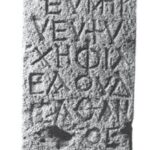| Artefact ID | 1291 |
| TM ID | TM 97443 |
| Findspot (DEChriM ID) | 68 (al-Filusiyya) | Class | Funerary element, Textual |
| Material | Stone |
| Writing medium | Inscription |
| Text content | Subliterary |
| Language | Greek |
| Description | SEG LIX 1882: Epitaph of Phileas. Dahari & Di Segni 2009, no. 10: Anthropomorphic stela of beach-rock, surmounted by a head; bottom tang broken. H. 130 cm; W. 35 cm; Th. 15 cm. The lines of the face and of the script are deeply engraved; no remains of paint. The inscription is regular, almost elegantly traced, with use of square and round letters. Some ligatures. Three crosses are engraved in the upper part of the body, above the epitaph. Same consolatory formula as in the other steles sharing the same provenance – a combination restricted to the northern coast of Sinai (el-Huweinat and el-‘Arish): εὐμοίρει, εὐψύχει, οὐδεὶς ἀθάνατος, “fare thee well, be of good courage, nobody is immortal”, accompanied by the name of the deceased in vocative. The name of the deceased is most likely the masculine Phileas (vocative: Philea), very common in the Greek lands as well as in Egypt – rather than the female name Φιλέα. |
| Selection criteria | Christian terms/formulas/concepts, Christian symbols/gestures/isopsephy |
| Date from | 350 |
| Date to | 499 |
| Dating criteria | Phrasing and palaeography point to late 4th-5th c. according to Dahari & Di Segni 2009. |
| Absolute/relative date | Relative date |
| Archaeological context | SEG LIX-1873-1882: One of the ten anthropomorphic stelai acquired in the antiquities market in the 1970s by the Israel Museum in Jerusalem and the Israel Antiquities Authority; returned to Egypt in 1993; all stelai come from the Byzantine nekropolis at el-Huweinat 2 km south of Ostrakine (east of Lake Sirbonitis = Sbakhat el-Bardawil; northern Sinai). |
| Accession number | Formerly: Jerusalem, Israel Museum, Shrine of the book 82.2.962; Tel Aviv, Private collection Dayan (previous). Returned to Egypt in 1993 (present location unknown). |


 Json data
Json data




